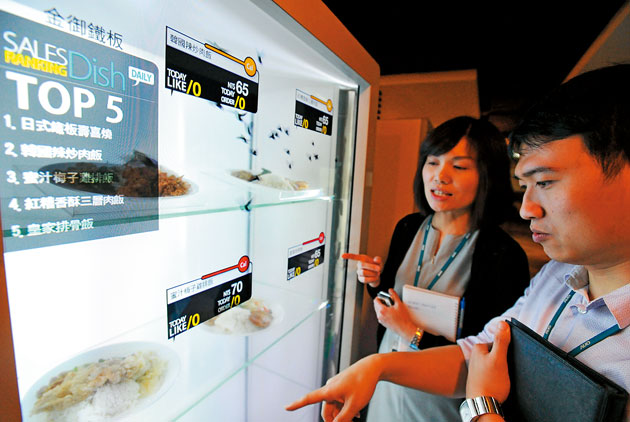AU Optronics
Eat Your Veggies, Get an iPad

Source:CW
When this leading display maker discovered that half its employees were overweight, it revolutionized the company dining hall, labeling each dish with an intelligent flat-panel display.
Views
Eat Your Veggies, Get an iPad
By Rebecca LinFrom CommonWealth Magazine (vol. 519 )
Au Optronics Corp. Human Resources Department assistant manager Amy Ku stared in disbelief at the numbers in front of her.
"Body mass index values of over 25, which are considered above normal, were at an unexpected high of 51.1 percent," the bespectacled Ku recalls of the moment three years ago when data from corporate employee medical examinations revealed that one in two of AUO's 45,000 employees nationwide was either already "overweight" or well on their way to getting there.
Employee health is most definitely not just a personal matter, Ku insists.
"In particular, if top executives experience health problems it can affect the reputation and share prices of the company," she notes.
Although the high proportion of rotund physiques in the technology sector was hardly a newsflash, Ku decided she had to act. A dietary revolution would be the first, and most important, step.
At 11:30 a.m., the corridors of the AUO plant gradually fill with people filing downstairs to the basement dining hall.
There are 3,000 employees at the AUO plant on Lising 2nd Rd. in the Hsinchu Science Park. The 860-seat dining hall must achieve 300-percent table turnover within two hours to keep pace with demand.
Meal management is no easy task. Ku's first task was to meet with institutional food vendors to demand they become a cooperative partner in the company's effort to look after the healthful diets of employees. That would mean not only less fat and less salt, but also a ban on the use of MSG.
Next up was making the dining hall "intelligent." At the bottom of the stairs at the dining hall entrance sit five clear cabinets affixed with flat-panel displays, each representing one of the food vendors inside. A multicolored display indicates the five most popular dishes from each vendor.
Those opting for curry chicken get a free pass with a green light. The soy sauce braised chicken and Cantonese roast pork combo, however, bears an ominous red warning light, indicating that the caloric content may be too high, and suggesting that it should not be eaten daily.
Inside the dining hall, people are lined up 40 to 50 deep at the roast pork vendor. It's the most popular stall in the house. For the employees, average age 31, the deliciously juicy-looking roast pork plate is too much to resist, despite the unsightly red warning light.
To further encourage healthier eating habits among its employees, the company has also opened a self-serve vegetarian buffet offering 28 to 30 different salad items and vegetarian dishes, in addition to the combined 70 variations of set meals on offer from the five dining hall vendors.
Dining Hall Use Doubles
R&D engineer Lin Yi-tsun, 33, eats breakfast, lunch and dinner in the dining hall every day.
"I'll usually go vegetarian a few meals per week," he says.
The wood ear and fresh greens on his plate are well on their way to being devoured.
The tariff was also changed from a flat NT$50 for all you could eat to a system of paying by weight to encourage more of a "take only what you're going to eat" mentality.
The changes did not drive away the employees. On the contrary, dining hall usage went from an average of 100 seatings per meal, to 250 and ultimately to 330 seatings per meal.
Just prior to the Lunar New Year holiday, the meals coordinator in AUO's human resources department, Jacky Peng – a "senior administrator," according to his name card – organized a four-week raffle, during which employees could accrue points from eating in the dining hall, with 10 points earning a chance in the raffle. Those opting for vegetarian items received two points, while the carnivores got one point. The top prize was an iPad.
"I had no idea people would start madly scrambling for points and even devising secret formulas for accruing the most points," he relates.
Dining hall vegetable consumption went through the roof, eventually reaching an apex of 480 person trips through the self-serve vegetarian line during one mealtime.
Actively pushing its dietary revolution, AUO not only conducts periodic employee satisfaction surveys, but also offers immediate feedback to the food vendors. Near the dining hall exit are three LCD displays provided for employees to register their opinions following their meals. Peng says he uses the information gleaned from this electronic suggestion box to discuss with vendors ways of tailoring menu items more toward employee tastes.
"When you do it well, then more people will eat and you will make more money. If you get it wrong, perhaps employees will opt to eat out," Amy Ku told vendors. Employee usage of the dining hall has gone from an average of 80 percent three years ago to 95 percent today.
One other unintended benefit has been that kitchen waste has been reduced dramatically. According to calculations tabulated at AUO's six plants nationwide, kitchen waste has fallen 70 percent from its previous average of 1,900 kilograms per day.
The improved meals have resulted in a steady decline in the overall BMIs of AUO employees.
"Over the past three years, each year 1,700 kilograms of excess body weight have been shed for every 1,000 employees," Ku says.
The health of its workforce is always a company's greatest asset.
Translated from the Chinese by Brian Kennedy






